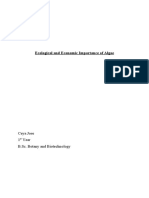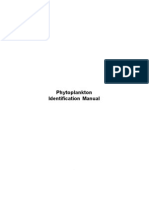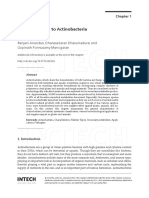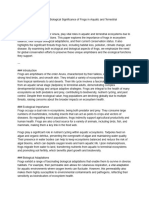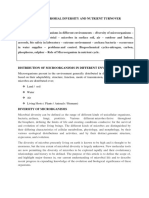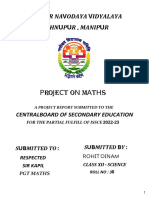The Impact of Biotechnology On Marine Fungal Diversity: P. S. Sridhar
The Impact of Biotechnology On Marine Fungal Diversity: P. S. Sridhar
Uploaded by
IAEME PublicationCopyright:
Available Formats
The Impact of Biotechnology On Marine Fungal Diversity: P. S. Sridhar
The Impact of Biotechnology On Marine Fungal Diversity: P. S. Sridhar
Uploaded by
IAEME PublicationOriginal Description:
Original Title
Copyright
Available Formats
Share this document
Did you find this document useful?
Is this content inappropriate?
Copyright:
Available Formats
The Impact of Biotechnology On Marine Fungal Diversity: P. S. Sridhar
The Impact of Biotechnology On Marine Fungal Diversity: P. S. Sridhar
Uploaded by
IAEME PublicationCopyright:
Available Formats
International Journal of Advanced Research in Engineering and Technology
(IJARET)
Volume 6, Issue 10, Oct 2015, pp. 113-117, Article ID: IJARET_06_10_016
Available online at
http://www.iaeme.com/IJARET/issues.asp?JType=IJARET&VType=6&IType=10
ISSN Print: 0976-6480 and ISSN Online: 0976-6499
IAEME Publication
___________________________________________________________________________
THE IMPACT OF BIOTECHNOLOGY ON
MARINE FUNGAL DIVERSITY
P. S. Sridhar
Professor, Marine Engineering, AMET University
Bhoopathy Bhaskaran
Professor-Marine Engineering, AMET University
M. Rajasekaran
Professor, Marine Engineering, AMET University
ABSTRACT
This paper mainly concentrates on the biotechnology view for the
exploitation of marine fungal diversity to represent its physic-chemical
properties in marine environment adaptation for the biotechnology
applications. These fungal species has the habitats of endophytic or fungi
associated marine algae or marine invertebrates especially like corals and
sponges found in detritus and extreme marine environment. Fungal species
associates in many biological activities such as decomposing plant material,
production of bioactive compounds in plants and animals due to the presence
of degrading enzymes and also find its application in paper and pulp
industries and bioremediation. The deep sea environment adapted fungi is yet
to be explore for its sources of biotechnology application, though these
environment has high hydrostatic pressure with low temperature or
hydrothermal conditions. Understanding the adaptation for fungal species is
used to investigate the novel compounds to use in biotechnology application.
Key words: Endophytic, Hydrothermal, Bioremediation.
Cite this Article: P. S. Sridhar, Bhoopathy Bhaskaran and M. Rajasekaran.
The Impact of Biotechnology on Marine Fungal Diversity. International
Journal of Advanced Research in Engineering and Technology, 6(10), 2015,
pp. 113-117.
http://www.iaeme.com/IJARET/issues.asp?JType=IJARET&VType=6&IType=10
http://www.iaeme.com/IJARET/index.asp
113
editor@iaeme.com
P. S. Sridhar, Bhoopathy Bhaskaran and M. Rajasekaran
1. INTRODUCTION
The application of fungi in biotechnology has been for last five decades, so it is
commonly known to as fungal biotechnology or mycotechnology. Many of the
researches had been taken for the terrestrial fungi which are used to produce
extracellular enzymes, antibiotics, protein production by the modern molecular tools.
Several articles compare the application and importance of the terrestrial and marine
fungal species. Therefore, marine fungi form an ecological balance and not belong to
taxonomic group. These marine fungi grow; sporulate for germination in sea water
exclusively. But the facultative marine fungi adapts to fresh water environment to
explore its diversity. So far 800 species of marine fungi have been reported. Fungal
species belonging to ascomycetes, anamorphs and basidiomycetes. Among the
straminipilan fungi belonging to the oomycetes which is fairly widespread in the
marine environment. This review is mainly focused on the ecology adaptation to
understand the fungal organisms for its unique characteristics of marine fungi and its
potential application in mycotechnology. This paper emphasis on (i) endophytic fungi
in marine algae, sea grasses, mangroves and its benefits (ii) fungi associated with
invertebrates like corals and sponges for their potential bioactive compound
production (iii) adaptation conditions of fungi from deep sea environment such as
high hydrostatic pressure with low temperature, hyper saline and oxygen deficient
sediments of Dead Sea marine environment.
2. COMMON FEATURES OF MARINE FUNGI ASSOCIATED
WITH MARINE ENVIRONMENT
It is very essential to know the unique properties of marine environment for the
application in marine biotechnology due to several reasons:
A good knowledge about the ecosystem to helps to survey the novel genes.
Physical factors of the environment adapts to the organisms influences the
biotechnology production, such factors are
Low temperature
High hydrostatic pressure at deep sea environment
salinity and pH :
Sea water has salinity of 33-35 ppt, when compared to fresh water less than 0.05%
salts. Hyper saline seawaters found in Dead Sea containing 50-100 ppt or 5-10% salts.
Terrestrial fungi grows best at pH 4.5-6.0, whereas facultative marine fungi grow at
pH 7-8 to produce various extracellular enzymes
low water potential:
It is one of most problem is faced by seawater, where the marine organisms need
to maintain their water potentials in cells to enable water uptake. Marine fungi
maintain them by accumulating osmolytes like polyol, glycerol, etc. Marine yeasts
capable to produce glycerol to maintain osmotic potential with increased salinity.
High concentration of sodium ions:
The presence of high concentration of sodium ions in seawater is one of the unique
properties to the marine living cells. Therefore, the presence of small concentrations is
also toxic to the living cells in the terrestrial as well freshwater environments. Most of
the marine fungal species are known to reduce the toxicity of sodium ions by
sequestering them in vacuoles or by efficient sodium efflux ATPase. Thus, it is the
http://www.iaeme.com/IJARET/index.asp
114
editor@iaeme.com
The Impact of Biotechnology on Marine Fungal Diversity
best tool to understand the physiology growth and enzyme production in the presence
of sodium.
Oligotrophic conditions
Nutrient poor and oxygen rich conditions are known to say as oligotrophic conditions,
where fungi grows on microscopic lenses, glass slides in terrestrial environment .
While in water surface nutrients are comparatively in low state results for non-free
growth of fungi but can be seen as micro-colonies in marine sediments.
3. ENDOPHYTIC FUNGI IN MARINE ENVIRONMENT
The fungi which are symbioses that lives in other living cells like plant tissues which
cause no harms or use them as a part of its life cycle are known to refer as endophytic
fungi and other organisms are also found to live in such atmospheres are bacteria and
actinomycetes. Several terrestrial endophytic fungi are called as lichens, have been
investigated for its novel compound for the use of mankind. With this same idea of
investigation on several fungi as endophytes of marine algae and plants to produce
secondary metabolites. Such intervention was resulted in the isolation of novel
polyketide ascosalipyrrolidinone from marine fungus Aschochyta salicorniae
associated with the marine green alga Ulva species and various isolations of fungi
associated with algal-fungal, marine mangroves, sea grasses etc. But these
interventions did not satisfy and has no idea whether these fungi are originally
supported as endophytic plants or they are the metabolites of such marine plants
doubtfully kept as unsuccessful. Still further investigations need to be carried out in
detail.
4. MARINE ANIMAL ASSOCIATED FUNGI
Several examples of terrestrial fungi associated with insects were found to produce
various metabolites have been reported, similarly marine fungi also associated with
the animals in marine environments. Association of fungi with marine animals ranges
in order of saprophytic-symbiotic-parasitic. Several fungal species associated with
marine invertebrates isolated from gut, gastro-intestinal parts of the fish reported to
produce interesting secondary metabolites. Such investigation reported to the
production of novel platelet activating factors (A, B, B1, B2) isolated from the culture
of phoma sample taken from the crab shell Chinocetes opilio. Similarly, sponges are
known to produce bioactive compounds active against fungi, bacteria, malaria, viral
organisms. Though, marine sponges are well known bio-fermentors for the marine
microorganisms like bacteria, fungi for the production of bioactive compounds.
Sponge-fungal like yeast species are highly worth to investigate for production of
endosymbiosis bioactive compounds. The bioactive compounds are produced from
the marine animal associated fungi need to examine for the culture in organic media
where there bioactive compounds are active against insects and anthropods.
5. MARINE FUNGI IN DETRITUS
The detritus formation is a critic process of re-mineralization in marine ecosystem; it
is due to the microorganisms feed on the dead organic matter for its food resulting in
decomposition by the production of extracellular degrading enzymes. Detritus
formation in coastal regions by marine macrophytes, particularly mangroves
contribute a large amount of organic matter in water. Such degrading enzymes has
vast role in biotechnological applications. Degrading enzymes like cellulases, xylases,
ligninases were isolated from terrestrial fungi find its application in paper and pulp
http://www.iaeme.com/IJARET/index.asp
115
editor@iaeme.com
P. S. Sridhar, Bhoopathy Bhaskaran and M. Rajasekaran
industries. With this experiments marine fungi also isolated for those enzymes, some
of those investigations results in various forms of biotechnology applications.
The marine fungi associated in detritus environment not only produce degrading
enzymes, they also capable in the production of secondary metabolites like polyketide
metabolite of obionin-A was isolated from the broth culture of Leptosphaeria obiones
obtained on salt marsh grass Spartina alterniflora. Similarly, it was reported from
Hawaiian mangrove for the production of metabolic compounds which are good
source of antibiotics. Therefore various numbers of antimicrobial compounds have
reported for woody colonizing marine fungi. Such ecological condition is very
important to know for the screening process in drug discovery.
6. DEEP SEA ENVIRONMENTAL FUNGI
Extreme marine environment conditions are found to elevate with hydrostatic pressure
and low temperature, whereas hydrothermal vents have hydrostatic pressure with high
concentration of metals and hyper saline water bodies and hypoxic conditions is seen
in coastal and offshore waters. Several pharmaceutical companies focused in extreme
marine environment fungal species for bioprospecting like bacteria. But the fungi
from these conditions did not help for that commercial application. But, some fungi
isolated from the deep-sea sediments at the depth of 5000 m in Central Indian Basin
under hydrostatic pressure of 200-300 bar has bio-tolerant potential for application in
commercial fermentors of large capacities (above 10,000- 50,000 L).
Deep sea has low temperature of 2-4C where the microbes survive at this
temperature have cold active enzymes which is used for waste digestion in food
processing and preservation, detergents in cold wash and also helps in conservation of
heat energy. Some deep sea fungi such as Aspergillus terreus produces alkaline
protease, serine protease shows maximum activity of 26% at 15C and about 10% at
2C but alkaline protease from another mesophilic species of Penicillium did not
show any activity below 35C. Investigations are also made on hyper saline water
fungi found in Dead sea invoke for the stress tolerance in recombinant yeast
production to govern several genes and also in genetic engineering for salt-tolerant in
agricultural applications.
Bacteria are well known for its denitrification process in terrestrial soil.
Comparatively, the same idea was investigated recently in terrestrial fungi under
anaerobic conditions. Therefore, marine fungi also play an important role in
denitrification in coastal waters under intermittent hypoxic conditions. Natural
degradation of crude oil were seen in filamentous fungi in the coastal waters has been
also reported. However, this has not received much attention because still more
discovery and screening of novel enzyme and bioactive compounds of enigmatic
microorganisms of extreme marine habitat fungi described as a common ancestor of
animals and fungi may provide as new tools for the study of evolutionary biology and
advanced biotechnological applications.
7. CONCLUSION
This paper reviews on the marine fungal biotechnology for its application in various
fields. It was concluded from this study, the applications of terrestrial fungi has more
advantage over marine fungi. So finally it was concluded that it need further
investigation of marine fungal species in future. The future studies recommended in
aspects for the production of novel compounds from endophytic marine fungi,
extreme marine environment fungal species for salt-tolerance in bioremediation
http://www.iaeme.com/IJARET/index.asp
116
editor@iaeme.com
The Impact of Biotechnology on Marine Fungal Diversity
process and its genomic and proteomic study for the bio-active compound for the
revolution in biological research.
REFERENCES
[1]
[2]
[3]
[4]
[5]
[6]
[7]
[8]
[9]
[10]
Alva, P., McKenzie, E.H.C., Pointing, S.B., Pena-Muralla, R. and Hyde, K.D.
(2002). Do sea grasses harbor endophytes? In: Fungi in Marine Environment
(ed. K.D. Hyde) Fungal Diversity Research Series 7:167-178.
Blomberg, A., and Adler, L. (1992). Physiology of osmotolerance in fungi.
Advances in Microbial Physiology 33: 145 -212.
Damare, S., Raghukumar, C., Muraleedharan, U.D. and Raghukumar, S.
(2006b). Deep-sea fungi as a source of alkaline and cold-tolerant proteases.
Enzyme and Microbial Technology 39: 172-181.
Fell, J.W., and Newell, S.Y. (1981). Role of fungi in carbon flow and
nitrogen immobilization in coastal marine plant litter systems. In: The Fungal
Community: Its Organization and Role in the Ecosystems. (eds. D.T.
Wicklow and G.C., Caroll), Marcel Dekker, Inc., New York: 665-678.
Hu, H.L., Jeewon, R., Zhou, D.Q., Zhou, T.X. and Hyde, K.D. (2007).
Phylogenetic diversity of endophytic Pestalotiopsis species in Pinus armandii
and Ribes spp.: evidence from rDNA and -tubulin gene phylogenies. Fungal
Diversity 24: 1-22.
Kis-Papo, T., Oren, A., Wasser, S.P. and Nevo, E. (2003). Survival of
filamentous fungi in hyper saline Dead Sea water. Microbial Ecology 45:
183-190.
Pointing, S.B. and Hyde, K.D. (eds.) (2001). Bio- Exploitation of
Filamentous Fungi. Fungal Diversity Research Series 6: 1-467.
Raghukumar, C. (2002). Bioremediation of coloured pollutants by terrestrial
versus facultative marine fungi. In: Fungi in Marine Environment. (ed. K.D.
Hyde) Fungal Diversity Research Series 7: 317-344.
E. Venkatesan, M. Pugazhvadivu, G. Sankaranarayanan and E. Raja. MgoBiodiesel Blend as Alternative To ULSD for Marine Engines. International
Journal of Advanced Research in Engineering and Technology, 6(8), 2015,
pp. 83 - 93.
S. Solomon Raj and Dr. P.Ravinder Reddy. Bend-Twist Coupling and Its
Effect on Cavitation Inception of Composite Marine Propeller. International
Journal of Mechanical Engineering and Technology, 5(9), 2014, pp. 306 314.
http://www.iaeme.com/IJARET/index.asp
117
editor@iaeme.com
You might also like
- Abaqus Tube To Tube ModelingDocument9 pagesAbaqus Tube To Tube ModelingRachid DicharNo ratings yet
- Eng Nkojo ALGEA ECOLOGY AND PHYSIOLOGYDocument14 pagesEng Nkojo ALGEA ECOLOGY AND PHYSIOLOGYRajab HamisNo ratings yet
- Ecological and Economic Importance of AlgaeDocument12 pagesEcological and Economic Importance of AlgaeCeya JoseNo ratings yet
- Sinu NhalfDocument25 pagesSinu NhalfPranaya Kishore RaychoudhuryNo ratings yet
- Marine Macroalgae A Host For Epiphytic Microalgae at Bhavnagar District, Gujarat, IndiaDocument6 pagesMarine Macroalgae A Host For Epiphytic Microalgae at Bhavnagar District, Gujarat, IndiaEditor IJTSRDNo ratings yet
- Ajayiand Okoh 2014 JFEApublDocument6 pagesAjayiand Okoh 2014 JFEApublglendelcarla17No ratings yet
- Marine Drugs: ReviewDocument24 pagesMarine Drugs: ReviewGabriella Rdg'zNo ratings yet
- s40071 019 0221 1Document13 pagess40071 019 0221 1Rifqi Fathul ArroisiNo ratings yet
- Altivelis) at Floating Net Cage of Marineculture Management UnitDocument6 pagesAltivelis) at Floating Net Cage of Marineculture Management UnitIsnatul ShohifahNo ratings yet
- 2015 Hallmann AlgaeBiotechnology-GreenCell-FactoriesontheRiseDocument27 pages2015 Hallmann AlgaeBiotechnology-GreenCell-FactoriesontheRiseMurtadha JalalNo ratings yet
- Kualitas Perairan Tambak Udang Berdasar Parameter MikrobiologiDocument14 pagesKualitas Perairan Tambak Udang Berdasar Parameter MikrobiologirurikaimudinNo ratings yet
- Phytoplankton Manual OceanographyDocument40 pagesPhytoplankton Manual Oceanographybbdda100% (1)
- Bioactive CompoundDocument16 pagesBioactive CompoundBagas Alfrian SyahNo ratings yet
- Kbie 11 01 1711626Document14 pagesKbie 11 01 1711626Abner VieiraNo ratings yet
- Lab Report 4!Document10 pagesLab Report 4!nurul ainNo ratings yet
- Department of Zoology: MaricultureDocument21 pagesDepartment of Zoology: Mariculturesaman aslamNo ratings yet
- AlgaeDocument24 pagesAlgae09ANKIT MISHRA100% (1)
- AlgaeDocument10 pagesAlgaeapi-612669722No ratings yet
- Olugbojo - Comparative Studies of Bacteria LoadDocument10 pagesOlugbojo - Comparative Studies of Bacteria LoadajhrhyneNo ratings yet
- Bioremediation: Eco Technology of Cultured Water Using Efficient Microbes (ECO Microbes)Document6 pagesBioremediation: Eco Technology of Cultured Water Using Efficient Microbes (ECO Microbes)NehaNo ratings yet
- Study Material On Medicinal Uses of Marine SpongesDocument12 pagesStudy Material On Medicinal Uses of Marine SpongesSuchismita BanerjeeNo ratings yet
- Biology of Algae Lec 6Document16 pagesBiology of Algae Lec 6farhanbinhabibNo ratings yet
- Marinedrugs 05 00220Document22 pagesMarinedrugs 05 00220John BNo ratings yet
- Literary Analysis and Interpretation - Spanish - Foreign Language - 12th Grade Infographics by SlidesgoDocument16 pagesLiterary Analysis and Interpretation - Spanish - Foreign Language - 12th Grade Infographics by Slidesgovishuop061No ratings yet
- Algal Origin and DiversityDocument18 pagesAlgal Origin and DiversityArunchand RayarothNo ratings yet
- ningrum2019Document11 pagesningrum2019Sandy Wahyu DNo ratings yet
- 7470148Document25 pages7470148Sine Summsun PradhanNo ratings yet
- Chapter One 1.0 1.1 OystersDocument44 pagesChapter One 1.0 1.1 OystersAkpan EkomNo ratings yet
- Blue Biotec Marineh PPT 1Document16 pagesBlue Biotec Marineh PPT 1Rene Ramilo100% (1)
- Flora and Fauna of Marine Ecosystem: Presented byDocument11 pagesFlora and Fauna of Marine Ecosystem: Presented bySANJAI POCONo ratings yet
- Protozoan Parasites of Vannamei Shrimp LitopenaeusDocument4 pagesProtozoan Parasites of Vannamei Shrimp LitopenaeusSaad AlfadaniNo ratings yet
- By Pratibha Kulkarni: Marine-Bacteria Actinomycetes: A Case Study For Their Potential in BioremediationDocument12 pagesBy Pratibha Kulkarni: Marine-Bacteria Actinomycetes: A Case Study For Their Potential in BioremediationAnonymous xMTF1MqNo ratings yet
- HABsDocument5 pagesHABsAbhay PatilNo ratings yet
- (Dissolved Oxygen) Research Final FullDocument56 pages(Dissolved Oxygen) Research Final FullHershey DulinNo ratings yet
- Eksplorasi Bakteri Yang Berasosiasi Dengan Karang Lunak Sebagai Alternatif Sumber Senyawa Bioaktif: Uji Hayati AntibakteriDocument7 pagesEksplorasi Bakteri Yang Berasosiasi Dengan Karang Lunak Sebagai Alternatif Sumber Senyawa Bioaktif: Uji Hayati AntibakteriIsnaNo ratings yet
- MCB 421Document27 pagesMCB 421olamideNo ratings yet
- Marine Bacteria: Potential Candidates For Enhanced BioremediationDocument11 pagesMarine Bacteria: Potential Candidates For Enhanced BioremediationFABIO DE LIMANo ratings yet
- Biotechnological Potential of Marine Sponges: Narsinh L. Thakur and Werner E. G. MüllerDocument7 pagesBiotechnological Potential of Marine Sponges: Narsinh L. Thakur and Werner E. G. MüllerIbnu AriyantoNo ratings yet
- MwandyaaaaaDocument23 pagesMwandyaaaaambojefadhilNo ratings yet
- Marinedrugs 13 01925 v2 PDFDocument41 pagesMarinedrugs 13 01925 v2 PDFAlbertochoNo ratings yet
- Essay On Hair AlgaeDocument2 pagesEssay On Hair AlgaeBeboy TorregosaNo ratings yet
- Introduccion A Las ActinobacteriasDocument36 pagesIntroduccion A Las ActinobacteriasALdo Garcia LizarbeNo ratings yet
- Chapter 2Document17 pagesChapter 2Kamal HossainNo ratings yet
- Effect of Light, Temperature and Salinity On The Growth of ARTEMIADocument8 pagesEffect of Light, Temperature and Salinity On The Growth of ARTEMIAinventionjournalsNo ratings yet
- 2016 Eksakta Vol 1 Tahun XVII2016 PrintedDocument9 pages2016 Eksakta Vol 1 Tahun XVII2016 PrintedMutawakkilNo ratings yet
- Effect_of_inoculation_of_the_cyanobacterDocument10 pagesEffect_of_inoculation_of_the_cyanobacterestudoscoletivos2024No ratings yet
- Live Feeds in AquaDocument5 pagesLive Feeds in Aquakamei321No ratings yet
- 1) AbstractDocument8 pages1) AbstractNani Gopal SahaNo ratings yet
- Marine Natural Product PDFDocument10 pagesMarine Natural Product PDFM Giano FadhilahNo ratings yet
- The Ecological and Biological Significance of Frogs in Aquatic and Terrestrial EcosystemsDocument2 pagesThe Ecological and Biological Significance of Frogs in Aquatic and Terrestrial EcosystemsMonkopaz ZebNo ratings yet
- Lecture #4 NotesDocument9 pagesLecture #4 NotesShanieque HarrisNo ratings yet
- Seaweed A Field ManualDocument42 pagesSeaweed A Field ManualIzzan RaziqinNo ratings yet
- US Rare Earth Minerals, Inc. - AquacultureDocument5 pagesUS Rare Earth Minerals, Inc. - AquacultureUSREMNo ratings yet
- Exploring Protozoa in Marine Aquaculture Ponds : A Comprehensive GuideFrom EverandExploring Protozoa in Marine Aquaculture Ponds : A Comprehensive GuideNo ratings yet
- Biofertilizer in RiceDocument6 pagesBiofertilizer in Ricemiguel prietoNo ratings yet
- MCB 403 Group 9-1Document12 pagesMCB 403 Group 9-1ejohn8340No ratings yet
- Environmental Microbiology UNIT 2Document23 pagesEnvironmental Microbiology UNIT 2Esai Kanaga YadavNo ratings yet
- Aquaponics systems, fish. Volume 3: Sistemas de acuaponíaFrom EverandAquaponics systems, fish. Volume 3: Sistemas de acuaponíaNo ratings yet
- Exploring the Ecological Dynamics : Interactions Between Fish and Birds in Aquatic EcosystemsFrom EverandExploring the Ecological Dynamics : Interactions Between Fish and Birds in Aquatic EcosystemsNo ratings yet
- Broad Unexposed Skills of Transgender EntrepreneursDocument8 pagesBroad Unexposed Skills of Transgender EntrepreneursIAEME PublicationNo ratings yet
- Influence of Talent Management Practices On Organizational Performance A Study With Reference To It Sector in ChennaiDocument16 pagesInfluence of Talent Management Practices On Organizational Performance A Study With Reference To It Sector in ChennaiIAEME PublicationNo ratings yet
- A Study On The Impact of Organizational Culture On The Effectiveness of Performance Management Systems in Healthcare Organizations at ThanjavurDocument7 pagesA Study On The Impact of Organizational Culture On The Effectiveness of Performance Management Systems in Healthcare Organizations at ThanjavurIAEME PublicationNo ratings yet
- A Study of Various Types of Loans of Selected Public and Private Sector Banks With Reference To Npa in State HaryanaDocument9 pagesA Study of Various Types of Loans of Selected Public and Private Sector Banks With Reference To Npa in State HaryanaIAEME PublicationNo ratings yet
- Voice Based Atm For Visually Impaired Using ArduinoDocument7 pagesVoice Based Atm For Visually Impaired Using ArduinoIAEME PublicationNo ratings yet
- A Study On Talent Management and Its Impact On Employee Retention in Selected It Organizations in ChennaiDocument16 pagesA Study On Talent Management and Its Impact On Employee Retention in Selected It Organizations in ChennaiIAEME PublicationNo ratings yet
- Role of Social Entrepreneurship in Rural Development of India - Problems and ChallengesDocument18 pagesRole of Social Entrepreneurship in Rural Development of India - Problems and ChallengesIAEME PublicationNo ratings yet
- Quality of Work-Life On Employee Retention and Job Satisfaction: The Moderating Role of Job PerformanceDocument7 pagesQuality of Work-Life On Employee Retention and Job Satisfaction: The Moderating Role of Job PerformanceIAEME PublicationNo ratings yet
- Various Fuzzy Numbers and Their Various Ranking ApproachesDocument10 pagesVarious Fuzzy Numbers and Their Various Ranking ApproachesIAEME PublicationNo ratings yet
- Application of Frugal Approach For Productivity Improvement - A Case Study of Mahindra and Mahindra LTDDocument19 pagesApplication of Frugal Approach For Productivity Improvement - A Case Study of Mahindra and Mahindra LTDIAEME PublicationNo ratings yet
- Optimal Reconfiguration of Power Distribution Radial Network Using Hybrid Meta-Heuristic AlgorithmsDocument13 pagesOptimal Reconfiguration of Power Distribution Radial Network Using Hybrid Meta-Heuristic AlgorithmsIAEME PublicationNo ratings yet
- A Proficient Minimum-Routine Reliable Recovery Line Accumulation Scheme For Non-Deterministic Mobile Distributed FrameworksDocument10 pagesA Proficient Minimum-Routine Reliable Recovery Line Accumulation Scheme For Non-Deterministic Mobile Distributed FrameworksIAEME PublicationNo ratings yet
- Financial Literacy On Investment Performance: The Mediating Effect of Big-Five Personality Traits ModelDocument9 pagesFinancial Literacy On Investment Performance: The Mediating Effect of Big-Five Personality Traits ModelIAEME PublicationNo ratings yet
- Analyzability Metric For Maintainability of Object Oriented Software SystemDocument14 pagesAnalyzability Metric For Maintainability of Object Oriented Software SystemIAEME PublicationNo ratings yet
- Camel Analysis of NBFCS in TamilnaduDocument7 pagesCamel Analysis of NBFCS in TamilnaduIAEME PublicationNo ratings yet
- A Review of Particle Swarm Optimization (Pso) AlgorithmDocument26 pagesA Review of Particle Swarm Optimization (Pso) AlgorithmIAEME PublicationNo ratings yet
- SaP Service DeskDocument22 pagesSaP Service Deskravikumarac16No ratings yet
- ASC GSD - Platform Org Chart and Scope - NycolleDocument8 pagesASC GSD - Platform Org Chart and Scope - NycolleNYCOLLE ALVESNo ratings yet
- Vanjari Saheb PPT Marathi 111Document92 pagesVanjari Saheb PPT Marathi 111sanket phadkarNo ratings yet
- The History of The Accelerometer: 1920s-1996 - Prologue and Epilogue, 2006Document9 pagesThe History of The Accelerometer: 1920s-1996 - Prologue and Epilogue, 2006msdn12000No ratings yet
- Electricity - The Magic MediumDocument201 pagesElectricity - The Magic MediumxanabrasNo ratings yet
- Microbiology and Sterility Assurance Book (2011)Document1 pageMicrobiology and Sterility Assurance Book (2011)Tim Sandle100% (1)
- (Cambridge Studies in Contentious Politics) Ronald Aminzade - Race, Nation, and Citizenship in Postcolonial Africa - The Case of Tanzania (2013, Cambridge University Press) PDFDocument448 pages(Cambridge Studies in Contentious Politics) Ronald Aminzade - Race, Nation, and Citizenship in Postcolonial Africa - The Case of Tanzania (2013, Cambridge University Press) PDFemmanuel santoyo rioNo ratings yet
- A Project Report On HR Policies and PracticesDocument19 pagesA Project Report On HR Policies and PracticesNeekita Khanal100% (1)
- Leica M: Process BookDocument46 pagesLeica M: Process BookMadisonNo ratings yet
- Week 1 Remediation Topics For StudentsDocument11 pagesWeek 1 Remediation Topics For StudentsJamela CadigalNo ratings yet
- Existing in Cold Harsh Reality. - THE WALL SPEAKSDocument7 pagesExisting in Cold Harsh Reality. - THE WALL SPEAKSMaduluNo ratings yet
- Deep Foundations Under Static Axial Compressive Load: Standard Test Methods ForDocument3 pagesDeep Foundations Under Static Axial Compressive Load: Standard Test Methods ForManba NSNo ratings yet
- High School Department: Syllabus in Research IiDocument12 pagesHigh School Department: Syllabus in Research IiLette C. DavilaNo ratings yet
- Catia v5 Detail Drafting1Document111 pagesCatia v5 Detail Drafting1Pramod Guruswamy100% (1)
- Biped Walk Cycle Quick ReferenceDocument4 pagesBiped Walk Cycle Quick ReferenceRaziq RidzuanNo ratings yet
- 12 - Text and Subtext in Print AdsDocument17 pages12 - Text and Subtext in Print Adsapi-3058454890% (1)
- HTR-001 - Personnel AdmininistrationDocument29 pagesHTR-001 - Personnel AdmininistrationShailja KrishnaNo ratings yet
- 2024 2024 Form 3 English of Work Term 3 With Samaritan Schemes of WorkDocument10 pages2024 2024 Form 3 English of Work Term 3 With Samaritan Schemes of WorkmarymuenipeterNo ratings yet
- Dustin Villarreal Resume IDocument1 pageDustin Villarreal Resume IDustin VillarrealNo ratings yet
- Congruent Triangle Proofs & CPCTCDocument14 pagesCongruent Triangle Proofs & CPCTCKimverly Ledda GanadenNo ratings yet
- 12 Tips: To Become ADocument10 pages12 Tips: To Become Ajahangir perfumersNo ratings yet
- ALIEN MathsDocument20 pagesALIEN MathsRobert YurembamNo ratings yet
- 03 - Drawing in MicroStationDocument7 pages03 - Drawing in MicroStationmunirNo ratings yet
- ThermodynamicsDocument35 pagesThermodynamicsmaheshluintelNo ratings yet
- DGS-3000-28SC - CLI Reference Guide - R5.0 PDFDocument975 pagesDGS-3000-28SC - CLI Reference Guide - R5.0 PDFdiego monroyNo ratings yet
- ZiiRii Proposal For Phillip Khan-PanniDocument9 pagesZiiRii Proposal For Phillip Khan-PanniAnonymous 2uIakwiNo ratings yet
- Intra Operative Neurophysiologic Monitoring: A) Motor Evoked PotentialsDocument8 pagesIntra Operative Neurophysiologic Monitoring: A) Motor Evoked PotentialsJeyarajasekar TtrNo ratings yet
- Lab Report Instructions and ExampleDocument8 pagesLab Report Instructions and Exampleapi-278476928No ratings yet


